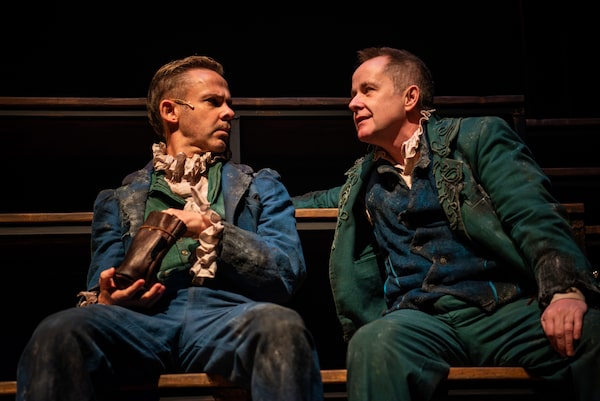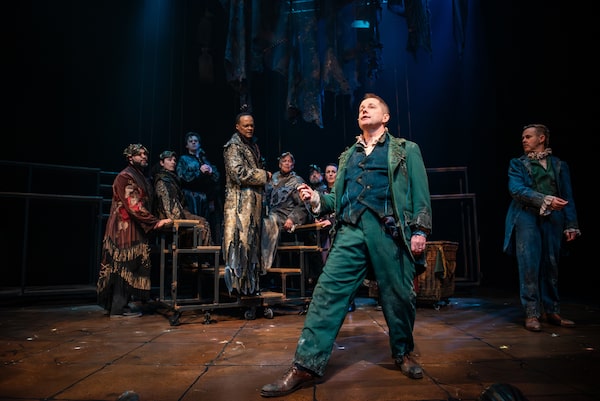
Dominic Monaghan, left, as Rosencrantz, and Billy Boyd, as Guildenstern, in Rosencrantz and Guildenstern are Dead.Stoo Metz - www.stoo.ca/Mirvish
- Title: Rosencrantz and Guildenstern are Dead
- Written by: Tom Stoppard
- Director: Jeremy Webb
- Actors: Dominic Monaghan, Billy Boyd and Michael Blake
- Company: Neptune Theatre and Mirvish Productions
- Venue: CAA Theatre
- City: Toronto
- Year: To April 6
Critic’s Pick
Rosencrantz and Guildenstern are Dead, now on at the CAA Theatre, was already one of theatre’s great cultural mash-ups.
British playwright Tom Stoppard’s witty breakout hit from 1966 retells Shakespeare’s Hamlet from the perspective of secondary characters Rosencrantz and Guildenstern – and does so in the absurdist style of Samuel Beckett’s Waiting for Godot.
In director Jeremy Webb’s new production visiting Toronto from Neptune Theatre in Halifax, however, there’s an added pop-culture cherry on top: A pair of actors known for playing minor roles in a famous trilogy of movies are playing the minor roles from a famous play elevated to unexpected star status in Stoppard’s show.
Guildenstern and Rosencrantz are Billy Boyd and Dominic Monaghan, whom you may remember as the comic-relief hobbits Merry and Pippin – or is that Pippin and Merry? – in filmmaker Peter Jackson’s Oscar-winning films based on J.R.R. Tolkien’s Lord of the Rings.
This isn’t exactly star casting – but then neither is it quite stunt casting. It’s simply symbiotic casting – the two British actors acquitting themselves well in the title roles, the memory of their on-screen bromance helpful in making the themes of Stoppard’s play land with demographics better versed in Tolkien than theatre history.
R&G RIP, as Stoppard’s play is sometimes known in shorthand, begins in memorably metaphysical fashion, with Guildenstern flipping coin after coin after coin and each one landing heads. He is puzzled as to how probability has got so out of joint – and ruminates about whether “un-, sub- or supernatural forces” are at play.
Boyd, with his sonorous Scottish accent, is excellent at wrestling the play’s rhetoric in moments like these (of which there are many over its three acts), debating himself in confident circles to uncertain conclusions about whether he is alive or dead.
Rosencrantz is more sanguine about the situation with the coins – but then again he’s the one calling heads and pocketing them. Still, his mind, too, often strays to thoughts of shuffling off mortal coils, as well as strange thoughts about, for instance, the curious “scientific” fact that the fingernails and beards grow after death.

Boyd, with his sonorous Scottish accent, is excellent at wrestling the play’s rhetoric, debating himself in confident circles to uncertain conclusions about whether he is alive or dead.Stoo Metz - www.stoo.ca/Mirvish
“The fingernails also grow before birth, though not the beard,” he says, trying hard to philosophize like his friend. “The toenails, on the other hand, never grow at all.”
As this less smart of the title two, Monaghan frequently bugs his eyes out in incomprehension or fright, or lifts his legs and crosses them in the air like a restless child; his performance isn’t always deep, but he’s a more than competent clown.
Unlike Vladimir and Estragon in Godot, Rosencrantz and Guildenstern do not spend much time waiting for someone to show up. It doesn’t take long for a Player (the Stratford Festival’s Michael Blake, in a fine and moving performance) to arrive with a travelling troupe of actors to engage in a series of discussions and demonstrations about holding up the mirror to life (and death).
Soon enough, the other characters from Shakespeare’s play make their way on stage, too – Claudius, Gertrude, Ophelia, Polonius (in the welcome form of Walter Borden) and then Hamlet himself (Pasha Ebrahimi, playing the “stark raving sane” part with a pomposity that stays just shy of parody). Indeed, each scene from Shakespeare that includes Rosencrantz and Guildenstern is staged.
Stoppard’s play is about being a part of a major story but not having the agency to affect where it goes – and never really being able to understand the entirety of what’s going on. Philosophically then, it is about life, as experienced by almost everyone.
More recently, however, as details about Stoppard’s early life have been revealed to him and then the world, the play has also seemed to be subconscious autobiography.
Born in 1937 as Tomas Straussler in what’s now the Czech Republic, the playwright and his Jewish family first fled the German occupation to Singapore, and then fled the Japanese invasion to India. Straussler’s father died in the second of those escapes – and he ended up growing up in England, a Stoppard, after his mother married a British army officer of that name.
Rosencrantz and Guildenstern can be read as two halves of one character in an identity crisis, as they constantly struggle to remember their past and even their own names; the playwright Tom, too, both Straussler and Stoppard, did not recover memories of where he had been and how he got to where he was until late in life. He was both very lucky, compared with more than a million other Jewish children; and very unlucky. His coin landed heads over and over, but it also landed tails repeatedly.
The weight of that history is under the surface of Webb’s production, dimly lit by Leigh Ann Vardy. But the staging never feels too weighty thanks to a smart set design by Andrew Cull comprised of two bleachers on wheels; the actors constantly clamber up and down its stairs and benches in well-wrought movement choreographed by Angela Gasparetto. (The height of the CAA Theatre has never been so well used in service of a play.)
Rosencrantz and Guildenstern may go nowhere for close to three hours, but they go nowhere fast. While I’ve yet to see a production of this play that has entirely won me over to it as a great play rather than a great first play, Webb’s definitely comes up heads more often than not.
 J. Kelly Nestruck
J. Kelly Nestruck